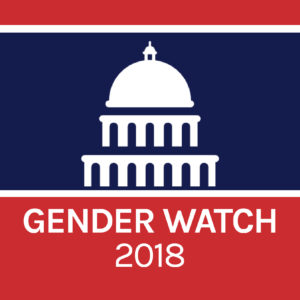2019 could see the largest freshman class of congresswomen since 1993.
 From March to December 2018, the Barbara Lee Family Foundation (BLFF) and the Center for American Women and Politics (CAWP) partnered to offer Gender Watch 2018, which tracked, analyzed, and illuminated gender dynamics in the 2018 midterm elections. With the help of expert scholars and practitioners, Gender Watch 2018 furthered public understanding of how gender influences candidate strategy, voter engagement and expectations, media coverage, and electoral outcomes in campaigns. The blog below was written for Gender Watch 2018, as part of our collective effort to raise questions, suggest answers, and complicate popular discussions about gender’s role U.S. elections.
From March to December 2018, the Barbara Lee Family Foundation (BLFF) and the Center for American Women and Politics (CAWP) partnered to offer Gender Watch 2018, which tracked, analyzed, and illuminated gender dynamics in the 2018 midterm elections. With the help of expert scholars and practitioners, Gender Watch 2018 furthered public understanding of how gender influences candidate strategy, voter engagement and expectations, media coverage, and electoral outcomes in campaigns. The blog below was written for Gender Watch 2018, as part of our collective effort to raise questions, suggest answers, and complicate popular discussions about gender’s role U.S. elections.
This post was originally shared via the Washington Post’s About US newsletter.
In the 26 years — and 12 election cycles — since women nearly doubled their representation in Congress, predictions of another “year of the woman” have been frequent, but often premature. They have also been ill-defined. What makes for a “year of the woman” in U.S. elections? Is it about the number of women who run? The number of women who win? The influence of female voters? The combination of these things? Or something else?
I have suggested we get rid of this moniker all-together in order to normalize women’s political success instead of characterizing it as an anomaly. Still, it is worth noting how this year’s gains for women in Congress might compare to the historic gains women made in congressional representation 1992.
From Election Day in 1992 to Inauguration Day in 1993, the number of women in Congress increased by 22 (from 31 to 53) and the percentage of women across both chambers jumped from 5.8 percent to 9.9 percent, according to the Center for American Women and Politics at Rutgers University. Contributing to this rise in women’s representation was the success of 28 non-incumbent women to the U.S. House and Senate, a record for women newcomers that has held for over two decades.
In 2018, this record may well be broken. A week before Election Day 2018, 24 non-incumbent women candidates for the House — 22 Democrats and two Republicans — are favored to win, according to Cook Political Report. Another 16 women are in contests rated as toss-ups. In Senate contests, a new female senator is all but guaranteed in Arizona and two more non-incumbent women are running in competitive contests in Nevada and Tennessee.
Based on these predictions, it is not guaranteed that 28 or more non-incumbent women will be elected Tuesday, but appears more possible than in any election year since 1992.
Also notable is the diversity among the non-incumbent women who could be elected to Congress. Of the 24 women favored to enter the House for the first time in 2019, nine are women of color — including the first Native American woman to serve in Congress, the first Latinas to serve in the Texas congressional delegation, and the first women of color to represent Connecticut, Kansas, Massachusetts and Minnesota in our nation’s capital. Two women favored to win next week — Alexandria Ocasio-Cortez, who is running to represent New York in the House, and Abby Finkenauer, who is running to represent Iowa — would also become the youngest women elected to Congress, and Ilhan Omar of Minnesota and Rashida Tlaib of Michigan are likely to become the first Muslim women to serve in the U.S. House or Senate.
There are other measures by which we could compare progress for women this year to 1992. Will female representation in Congress jump by 4.1 percentage points next year, as it did 26 years ago? That will require women to hold 129 seats (up from 107) — or 24.1 percent of all seats — in the 116th Congress. Possible, but not at all a foregone conclusion. In 1992, female political representation increased by 71 percent. For women to match this percentage increase in 2018, they would have to reach 183 women in total between the House and Senate, a highly unlikely outcome.
There are many measures by which to measure women’s political success this year and not all of them are limited to the numbers of women who run and win. Beyond breaking records, female candidates in 2018 have continued the work of the women who have come before them to disrupt the images and norms of political leadership. They have challenged the prevailing rules of the game on the campaign trail and pushed voters to think differently about what we value in our elected leaders. That type of success for female candidates is not constrained to any single year, whether it is 1992 or 2018.


